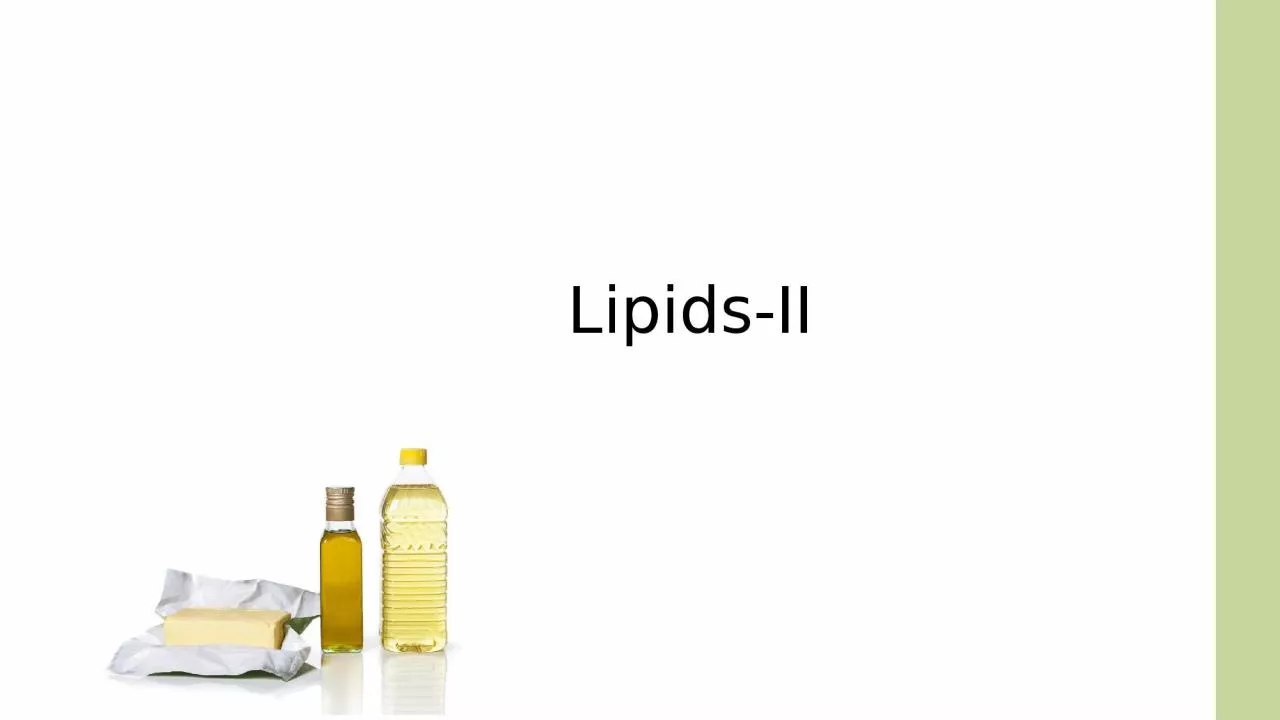

ASaturated Fatty Acids Fatty acids have no double bonds side chain are alkane 1 Short chain FA From 4 to 10 Carbon atoms and present as liquid in room Temp 2 Long chain FA More than 10 Carbone atoms present in ID: 917443
Download Presentation The PPT/PDF document "Lipids-II Fatty Acids can be classified..." is the property of its rightful owner. Permission is granted to download and print the materials on this web site for personal, non-commercial use only, and to display it on your personal computer provided you do not modify the materials and that you retain all copyright notices contained in the materials. By downloading content from our website, you accept the terms of this agreement.
Slide1
Lipids-II
Slide2Fatty Acids can be classified to:
A-Saturated Fatty Acids:
Fatty acids have no double bonds ,side chain are (alkane).
1) Short chain FA:
From 4 to 10 Carbon atoms ,and present as liquid in room Temp. 2) Long chain FA:More than 10 Carbone atoms, present in solid at room Temp. e.g. Palmatic (16) acid and Stearic(18) acid.
Slide3B-Unsaturated Fatty Acids:
have one or more double bonds between carbon atoms side chain.[has at least one double bond].
1) Essential Fatty acids:
Can not be synthesized in the body
linolenic acid18-C, 3 double bond (ω-3)Linoleic acid 18-C, 2 double bond (ω-6)2) Non essential Fatty acids:Can be synthesized in the body: Oleic acid
Slide4Practical Part
Slide51-Copper acetate test:
Objective:
This test is used to distinguish between oil [neutral fat] and fatty acid [saturated and unsaturated].
Principle:
The copper acetate solution does not react with the oils (or fats), while fatty acids [saturated and unsaturated ] react with copper acetate to form copper salt. Copper salt formed in the case of fatty acids can only be extracted by petroleum ether.
Slide6Method:
1. Take two test tubes add 3 ml of petroleum ether and an equal volume of a solution of copper acetate.
2. Add 0.5 ml of each sample in each tube
3. Shake the tube and leave it for some time.
CommentObservationOlive oilOleic acidResult :
Slide7olive oil:
notice that petroleum ether upper layer containing the dissolved oil and appears colorless.
aqueous solution remains blue in the bottom.
petroleum ether and dissolved oil
copper acetate
Slide8Oleic acid:
The upper layer of petroleum ether becomes green as a result of copper
oleate
[copper salt]. The lower layer becomes less in blue. copper oleate in the petroleum ether copper acetate
Slide92-Liebermann -
Burchard Test [acetic anhydride test] :
Objective:
To detect the presence of cholesterol.
Principle:Liebermann - Burchard Test , is a chemical estimation of cholesterol, the cholesterol is react as a typical alcohol with a strong concentrated acids and the product are colored substances. -Acetic anhydride are used as solvent and dehydrating agents. -Sulfuric acid is used as dehydrating and oxidizing agent .
-A positive result is observed when the solution becomes
red or pink
, then
blue
, and finally
bluish –green
color.
Slide10Method:
1. Dissolve a few crystals of cholesterol in 2 ml of chloroform in a dry test tube
2. add 10 drops of acetic anhydride
3. Add 2 to 3 drops of conc. sulfuric acid
CommentObservationTubecholestrolOlive oil
Result :
cholestrol
Olive oil
Slide113-Unsaturation Test:
Objective:
Determine the
degree of saturation
of different types of oils.Principle:All neutral contain glycerides of some unsaturated fatty acids. These unsaturated fatty acids become saturated by taking up iodine. Halogens ( I, Br ) will add across the double bonds and thus the decolorization of iodine or bromine solution will indicate the presence of unsaturated fatty acids.
Slide12Method:
Equally into 2 flask Add 10 ml of Chloroform then 10 drops of Hub’s iodine reagent (alcoholic solution of iodine containing some mercuric chloride),
the chloroform shows pink color due to presence of iodine
.
To one test flask add the olive oil sample drop by drop shaking the tube vigorously for about 30 seconds after addition of each until the pink color is discharged and count the number of drops. To the second flask add the butter sample by the same method.The pink color is discharged due to the taking up of iodine by the unsaturated fatty acids of the oil.
Compare unsaturation ,
it should be remembered that
more
the number of drops of the sample (fat) required to discharge the pink color, the
less the unsaturation (saturated)
, because fat contains less unsaturated fatty acids, it will take up
less iodine per drop
due to
low number of double bonds
(so it will need more drops of fat sample to take up all iodine and decolorize the pink color). Vice versa.
There is an
inverse relationship
between
number of fat drops required
and
number of double bonds
.
Slide13Slide144-acrolein test:
Objective:
is used to detect
glycrol
or fats.-Most lipid are found in the form of triglycerides, an ester formed from glycerol and fatty acids. Principle: When a fat is heated strongly in the presence of a dehydrating agent such as KHSO4 [potassium bisulphate], the glycerol portion of the molecule is dehydrated to form the unsaturated aldehyde, acrolein CH2=CH-CHO. which can be distinguished by its irritating acrid smell and as burnt grease.
Slide15- Other way
to detect lipids is by dye Sudan IV
(general dye for lipid ), which
produce red color
with lipid. Sudan IV (general dye for lipid )
Slide16Questions:
Why olive oil does not form green color in copper acetate test ?
What do you expect if you used palmitic or linoleic acid in copper acetate test ?
Why
acrolein test is used as a general test for oils and fats? Do you expect to get a positive result if you use free fatty acid like oleic acid or palmitic acid in acrolein test? and why ? Why iodine color discharged after addition of oil ?